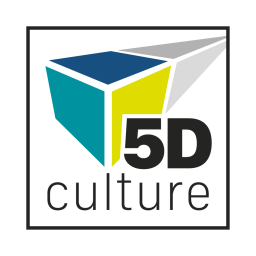5Dculture Consortium Meeting in Ferrara (IT)
Ferrara, Italy – 9 – 10 April 2024 – An international consortium of 12 partners, dedicated to enriching and expanding 3D digital cultural heritage repositories, recently gathered in the UNESCO World Heritage city of Ferrara. Hosted by local partner Inception at the University of Ferrara’s Department of Architecture, this meeting provided an invaluable opportunity for consortium members to share updates on their project activities and engage in workshops focused on capacity building and sustainability.
Exploring Capacity Building and Knowledge Sharing
Within a first workshop, the project team explored how the knowledge and tools created within 5Dculture can assist cultural heritage professionals beyond the consortium. Bases on the
Europeana guidelines for delivering training and development, the workshop included a creative exercise where small groups designed fictional magazine covers to crystallize intended learning outcomes and target audiences. Sebastiaan ter Burg, Knowledge Development Specialist at Europeana Foundation Netherlands and Capacity Building expert for 5Dculture, reflected on the workshop, saying, “It was a fun and creative process, tapping into the imaginative reservoirs of our team members to reflect on the knowledge and tools that our project has already brought forward. We are happy to be able to share this with a wider cultural heritage community and foster synergies.”
Resource Sharing and Community Building
Visitors to the project`s website can now discover a treasure trove of information resources, including articles, videos and guidelines dedicated to 3D content and cultural heritage. The
Community of Practice section features a curated collection of valuable insights, which will continue to grow with new contributions from consortium members in the coming months.
Breaking Ground in 3D Reuse Cases
At the heart of 5Dculture’s mission lies the exploration of reuse cases for 3D digital content in cultural heritage. With a focus on fashion heritage, archaeology, and architecture, the consortium has been spearheading groundbreaking collaborations between heritage preservationists, academic institutions, and technology providers.
- Under the lead of European Fashion Heritage Association (EFHA) the teams at Central Museum Utrecht (CMU) and The Netherlands Institute for Sound and Vision, supported by the developers and software engineers from FBK and CWI, have developed two reuse scenarios: a first set-up of a virtual fitting room is included in the current exhibition “Mode * Chapeau” at CMU in Utrecht, Netherlands where visitors can try on historical hats using Camera Kit AR SDK of Snapchat. The exhibition runs from 8 May to 29 September 2024
- Also in the Netherlands at the Sound and Vision headquarters in Hilversum, visitors will be able to explore selected 3D-digitised fashion pieces from CMU and other museums of the Modemuze network through an interactive Virtual Reality (VR) experience. With the help of camera equipment and social VR tools, people will be able to visit a 3D virtual space at the simultaneously while physically being in different locations. The exhibit will take place between 26-28 June 2024.
- The colleagues from The Discovery Programme have been working on improving the quality of already digitised and published archaeological treasures from Ireland (from the Neolithic burial mounds of Brú na Bóinne to early mediaeval High Crosses) while also cooperating closely with 5Dculture`s technology partners Arctur and Inception; working on new visualisation methods for sites with limited accessibility, most valuable for both tourism and conservation. Additionally, the team is exploring different ways to creatively and artistically reuse 3D archaeological content, for example as casting moulds for different materials (from plaster to chocolate).
- At the University Research Institute for Iberian Archaeology at the University of Jaén, Spain, the project team continues using haptic 3D prints of archaeological artefacts in education. Introducing children and young adults to the history of the Iberians, a prominent human society inhabiting the southern and eastern regions of the Iberian Peninsula during the Iron Age (6th-1st century BC), has been successfully managed on various occasions via workshops and other similar events. 3D prints of Iberian artefacts are not only used to educate school children, but also cater to individuals with visual impairments. Adding to this aspect of inclusion, the team also produced descriptive audio files (Spanish and English) to accompany the available 3D models to be integrated into Europeana.
- Under the lead of Time Machine Organisation (TMO) the team is assessing different use cases in connection with architecture, urban and historic development, working with viewer applications - desktop and mobile solutions - to visualise historic cityscapes at different moments in time to demonstrate the growth and development of a city, using data from historical maps and photographs to enhance the data.
- Project partners Arctur (works closely with different smaller scale touristic destinations in Slovenia), together with IN2 (develops digital storytelling solutions), developed an innovative way in which already available 3D data and visualisations connected to heritage sites can be used to create new cultural tourism products. Starting with a physical postcard, visitors coming to Idrij (Slovenia) can enjoy digital stories about a few selected historical sites, holding in the palm of their hand a hologram of said sites and exploring them in detail thanks to their high-quality 3D representation.
The meeting also addressed technical issues such as data storage, ingestion into Europeana, and the sustainability of project outcomes. Already, 50 new 3D models are available on Europeana via CARARE’s ‘Share 3D Dashboard’.
Charting the Course Ahead
The gathering in Ferrara highlighted the power of face-to-face collaboration in advancing digital heritage projects. The consortium looks forward to continuing their work and meeting again in person, inspired by the rich cultural heritage of Ferrara.
A PDF file of this article is available for download
here.



